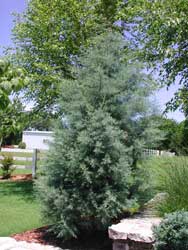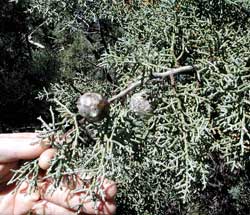Landscape Shrubs
Arizona Cypress
(Cupressus arizonica)
A high priority for the University of Arkansas Plant Evaluation Program is to identify alternatives to the overused and problem-susceptible redtip photinia (Photinia x fraseri) and leyland cypress (X Cupressocyparis leylandii). One good example of an alternative to these screen plants is the Arizona cypress (Cupressus arizonica).
There is a debate on the proper nomenclature for this group of plants. This is a botanical lumper-splitter type of project. Some experts separate C. arizonica from C. glabra. Other experts lump them and place glabra as a variety of C. arizonica. The distinction is not as important, however, as the potential this group offers for Arkansas gardens.
There are several reasons why this needle evergreen deserves more attention. First of all, the various cultivars all have an eye-catching silver-blue/powder blue color. The blue hue is even better than what you get with the blue atlas cedar (Cedrus atlantica ‘Glauca’). I love the cultivar names: ‘Blue Ice,’ ‘Blue Pyramid,’ ‘Carolina Sapphire,’ and ‘Silver Smoke.’
The second reason to admire this plant is for its rapid growth. For this reason it is grown frequently as a Christmas tree in the Southeast. So far the plant is also quite free of insect and disease problems. I have not observed bagworms, rust, or cankers like some other evergreen options.
The growth habit on young plants is very similar to our native Eastern red cedar (Juniperus virginiana). Because needles are not born in flat sprays like leyland cypress, the overall texture is very soft. Plants are pyramidal in shape and clearly taller than they are wide. As the plant matures it will open up. Very old specimens almost have a weeping, graceful appearance. ‘Blue Ice’ and ‘Blue Pyramid’ may have a much tighter pyramidal habit than ‘Carolina Sapphire.’ It is quite possible that many homeowners have purchased ‘Carolina Sapphire’ as a cut Christmas tree in Arkansas and did not know it.
Arizona cypress thrives on full sun exposure. The fabulous blue needle color will probably be diminished in more shade. While constant moisture might promote growth, an established plant should tolerate fairly dry conditions.
Need a cute fact for the next garden party? Arizona cypress is closely related to the artistic and beautiful Monterey cypress (C. macrocarpa) found along the California coast. Unlike its cousin, the Monterey cypress does not seem to like the heat and humidity of the south central U.S. Another garden party trivia note: Monterey cypress is one of the parents of the intergeneric hybrid leyland cypress.
So heads up, Arkansas gardeners. If you are looking for a hedge or screen alternative, you need to find Arizona cypress.
- Common Name: Arizona Cypress
- Varieties to look for: ‘Blue Ice,’ ‘Blue Pyramid,’ ‘Carolina Sapphire,’ ‘Silver Smoke’
- Flower Color: none
- Perennial or annual: needle evergreen
- Size: 45’ tall by 20’ wide
- Exposure: sun to partial shade
- Soil: tolerant
- Watering: moist best
- When to prune: not required
- Suggested use: screen/hedge, specimen
Form

Leaves and fruit
